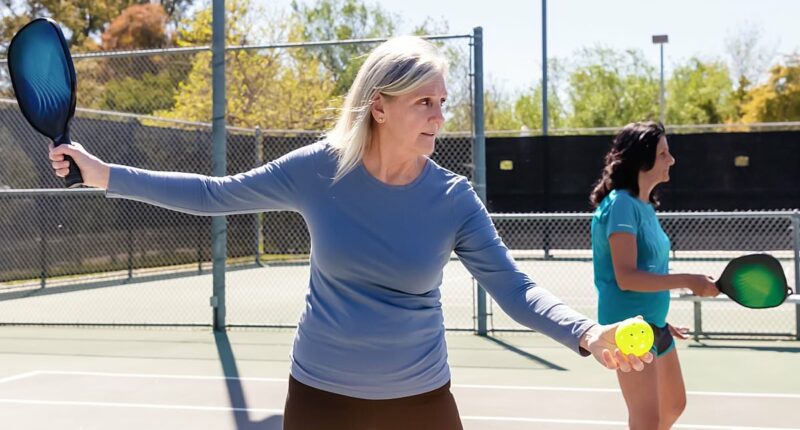Share this @internewscast.com
The Pickleball phenomenon has captivated millions, garnering a reputation akin to a ‘cult-like’ movement across the United States. Whether you’re a die-hard enthusiast or just curious, it’s hard to ignore the Pickleball surge.
This sport, characterized by its smaller courts, lower nets, and sturdy paddles paired with lightweight plastic balls, offers a more approachable alternative to traditional tennis. With over 20 million Americans regularly taking part and generating a $2 billion annual industry, Pickleball has firmly established itself in the mainstream.
While Pickleball is celebrated for its numerous health advantages—such as enhanced cardiovascular health, improved balance, and increased social interaction—it doesn’t come without potential hazards.
Recent research highlights a noticeable increase in eye injuries among Pickleball participants.
As the sport continues to expand at an unprecedented pace, particularly attracting novice players, the risk of eye injuries from errant balls, misused paddles, or unexpected falls may be on the rise.
Dr. Jonathan C. Tsui from Rutgers University in New Jersey, who led the study, noted that the surge in beginners unfamiliar with the nuances of the game has heightened the likelihood of injuries.
These players, he said, often are not accustomed to the speed of the ball or the proximity to other players on the court.
Dr Tsui’s interest in the subject began after a colleague was injured during a pickleball game, and while the number of eye injuries is relatively low, they can be severe.

Players aged 50 and above accounted for roughly 70 percent of these injuries. Researchers linked this susceptibility to age-related physical decline, including reduced muscle mass, bone density and balance (stock)
Dr Tsui determined that, from 2014 to 2021, about 200 pickleball players suffered a range of injuries, including retinal detachments, fractures to one or more of the bones that make up the eye socket, and hyphema, blood collecting in the front of the eye.
But as the sport has taken off, with thousands of indoor and outdoor courts being erected and groups of friends forming teams, eye injuries have grown by about 405 cases each year from 2021 to 2024.
Players aged 50 and older accounted for roughly 70 percent of all eye injuries. Researchers linked this heightened vulnerability to age-related physical decline, including reduced muscle mass, bone density and balance.
This study adds to existing reports of significant pickleball-related eye injuries.
Previous cases have included severe, vision-threatening conditions.
Previous severe injuries include retinal detachments, a serious emergency where the light-sensitive tissue at the back of the eye pulls, which can cause permanent blindness without surgery, and dislocated lenses, which impair focus and vision.
Tsui’s team used a nationally representative database to estimate that about 3,100 pickleball-related eye injuries were treated in emergency departments nationwide from 2014 to 2024. There were no reported injuries before 2014.
The problem skyrocketed from 2022 to 2024, with 88 percent of the injuries sustained occurring during that period.

Between 2005 and 2024, a national estimate of 137,471 pickleball-related injuries were recorded in US emergency departments. Of these, over 3,100 were eye injuries, with the vast majority (88 percent) occurring between 2022 and 2024
In 2024 alone, there were an estimated 1,262 such injuries.
The compact pickleball court positions players just 14 feet apart, allowing little time to react to a fast-moving ball or an overzealous paddle to the face.
According to the study, biomechanical analysis indicates that a ball traveling over 30 mph can deform the eye’s cornea, retina and vitreous humor, generating sufficient pressure to dislocate the lens.
Modern paddles can propel the ball at speeds up to 60 mph.
The most common causes of injuries included being hit directly by the ball, accounting for 43 percent of cases. Falls were the second-leading cause at 28 percent, followed by being struck by a paddle at 12 percent.
Injuries spanned all ages, but data indicate greater vulnerability in older players. Patients aged 60 and older sustained over half of all eye injuries, with the average age of those injured in a fall being 68.
Patients were most frequently diagnosed with cuts and bruises around the eye. The study also documented more severe injuries that could potentially lead to permanent vision loss, including retinal detachments, internal bleeding and orbital fractures.
New, casual players in the sport have likely contributed to the rise in accidents, due to limited experience, unfamiliarity with the game or a lower level of physical fitness.
Tsui told the New York Times: ‘We’ve seen a lot more players who are not familiar with the sport entering the court, and that creates a lot of opportunity for injury.
‘They’re not used to how fast the projectiles are moving and how close to the other players on the court they are.’
Despite the rising number of eye injuries, no major pickleball organization requires players to wear protective eyewear.
In March 2024, the sport’s national governing body rejected a rule to mandate tournament eye protection, citing enforcement challenges.
While the American Academy of Ophthalmology now recommends specific protective glasses, these guidelines are not widely promoted.
A lack of a clear, universal standard makes it difficult for players to find verified protective gear and undermines the broader adoption of safety measures.
The study was published in the journal JAMA Ophthalmology.















